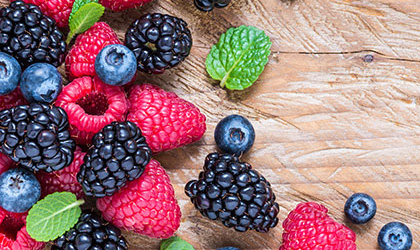
You’ve probably heard of ‘antioxidants’ (those little guys that protect your body from damaging compounds called free radicals), but what about ‘anthocyanidins’ – another buzzword to take the nutritional world by storm of late?
Anthocyanidins are the ‘Big Daddy’ of the antioxidant world. The cool thing about these nutrients is their capacity as antioxidants extend beyond kicking free radicals. A growing body of scientific research reveals they may also play a role in protecting tissues, cells and vital organs.
Let’s find out why everyone’s waxing lyrical about these powerful plant pigments.
Foods Rich in Anthocyanidins
Anthocyanidins are found in high concentrations in purple-coloured foods: blueberries, blackcurrants, blackberries, strawberries, pomegranate, black plums, aubergine, red cabbage, cherries and cranberries. Interestingly, it’s the anthocyanidins that give these veggies and fruit their dazzling purple, red, or blue pigments.
Anthocyanidins for Cardiovascular Support
Increasing evidence suggests a regular dietary intake of anthocyanidin-rich foods may support heart health. In the Iowa Women’s Health Study, which examined 34,000 postmenopausal women, researchers found participants who consumed strawberries and blueberries once per week or more saw a marked reduction in developing heart-related issues.1
Another large study led by scientists at the University of East Anglia and Harvard School of Public Health validated these findings.2 The investigation revealed women who ate three or more portions of strawberries and blueberries every week experienced a decrease in major cardiac events. The research drew on the data from 93,600 female nurses aged between 25 and 42, over an 18-year period.
If that wasn’t enough to convince you, further evidence from randomised, clinical trials highlighted that eating anthocyanidins found in blueberries, strawberries, and cranberries may support healthy cholesterol management.3,
Cognition
These powerful plant pigments have also demonstrated promise in supporting cognitive function. The purple sweet potato, rich in anthocyanidins, is also commonly eaten in Okinawa – a Japanese island, which is home to an unusually healthy, elderly population, with a large number of inhabitants over the age of 100.
Some experts believe the traditional consumption of purple sweet potato plays a role in keeping the Okinawans’ grey matter happy and healthy, supplying the brain with plenty of oxygen and blood.5 While we have to be mindful that the longevity of an Okinawan is unlikely to be down to this free racial-scavenging spud alone, it’s certainly food for thought.
Exercise performance and recovery
In recent years, anthocyanidins have gained quite a reputation in the sporting world. By lowering the negative effect of free radical accumulation during physical activity, it appears anthocyanidin-rich fruit juices, such as tart cherry juice, may have the antioxidant capacity to support physical performance and post-exercise recovery.
In one study published by the University of Northumbria, scientists assessed the impact of drinking tart cherry juice on marathon running.6 Researchers found the group who drank the cherry juice recovered their strength more quickly than the control group over a 48-hour period following the marathon. Free radical damage – a common side effect of long-distance endurance running – was also significantly reduced.
Immune Health
Owing to their rich antioxidant credentials, anthocyanidins may support immune health. A study published in Advances in Nutrition found anthocyanidins are involved in the respiratory tract’s immune defences.7 The report established those who ate food rich in these plant pigments were less likely to develop an upper respiratory tract infection or a common cold than those who didn’t.
Eye health
According to scientific data, anthocyanidins may also be a great addition for eye health. These plant pigments have been credited for reducing oxidative stress in the retina and offering anti-allergic and anti-viral support.8
Not only that, but these powerful compounds appear to support blood flow and circulation, too.9 A study published in the European Review for Medical Pharmacological Studies found bilberries – a concentrated source of anthocyanidins – may increase tear production, providing some relief for people who experience dry eyes.1
Collagen production
Collagen production is another area anthocyanidins really shine. Collagen is the protein found in your skin, responsible for giving it structure, elasticity and that much-desired ‘glow’. From the age of 20, however, your collagen production starts to decline, paving the way for fine lines, wrinkles and sagging skin as you age.
Research suggests anthocyanidins may play support collagen production.11 One study found these compounds may offer some protection against harmful UV rays from the sun, which accelerates ageing.12
Healthy collagen production isn’t only vital for radiant skin; it may also support your connective tissue and capillary walls. Clinical research has presented anthocyanidins as powerful weapons for fluid retention due to ‘leaky’ blood capillaries.13 Researchers suggest these plant pigments may have the capacity to repair and protect collagen in the capillary walls, thereby providing some relief from fluid retention.
Final thoughts
Anthocyanidins work their antioxidant magic in countless ways. From cognition to collagen production and eye health to exercise performance, there’s no doubt these plant powerhouses are good for us.
Thankfully, getting your anthocyanidin fix couldn’t be easier. Breakfast is a brilliant canvas for many of these foods. Think blueberry smoothies, porridge topped with strawberries or overnight oats and blackberries. Not berry season? Go frozen! Frozen berries are still chock-full of anthocyanidin goodness and an easy way to jumpstart your morning. Upping your anthocyanidin intake is about being creative. If you can spice up a dish with a burst of purple fruit or veg, go for it.
You can also find super-strength anthocyanidins – along with other powerful plant compounds, including lutein and green tea – in our specialist formula, Colladeen Visage.
FREE expert nutrition advice
Our dedicated Nutrition Advice department is a major reason for our success. Our Nutrition Advisors have a wealth of experience between them. They talk to thousands of customers every year, helping them make the right choice from our extensive product offerings. No matter how small your query, they’re happy to help. So, if you’re still unsure what to select, please do reach out via email, phone, or Live Chat.
Call: 01892 552 175
Email: nutrition@naturesbest.co.uk
Write: Nature’s Best Ltd. Century Place, Tunbridge Wells, Kent, TN2 3BE
Want to find out more?
Read more of our resources on ageing and related content here.
References:
-
Basu, A., Rhone, M. & Lyons, T.J. (2010). Berries: emerging impact on cardiovascular health. Nutrition reviews, 68(3), 168-77.
-
Cassidy, A., Mukamal, K., Liu, L., Franz, M., Eliassen, A. & Rimm, E. (2013). High Anthocyanin Intake Is Associated With a Reduced Risk of Myocardial Infarction in Young and Middle-Aged Women. Circulation, 127(2), pp.188-196.
-
Erlund, I., Koli, R. & Alfthan, G., et al. (2008). Favourable effects of berry consumption on platelet function, blood pressure, and HDL cholesterol. Am. J. Clin. Nutr. 87 (2), 323-331.
-
Lee, I.T., Chan , Y.C., Lin, C.W., et al. (2008). Effect of cranberry extracts on lipid profiles in subjects with type 2 diabetes. Diabet. Med., 25 (12), 1473-1477.
-
BBC Guides. (2018) How do I keep my brain young? Available online: http://www.bbc.co.uk/guides/zgxq6fr#zw2jxsg [Accessed 25 Oct. 2018]
-
Willcox, D.C., Scapagnini, G. & Willcox, B.J. (2014). Healthy aging diets other than the Mediterranean: a focus on the Okinawan diet. Mechanisms of ageing and development, 136-137, 148-62.
-
Tsuda, T., Horio, F., Uchida, K., Aoki, H. & Osawa, T. (2003). Dietary Cyanidin 3-O-β-D-Glucoside-Rich Purple Corn Color Prevents Obesity and Ameliorates Hyperglycemia in Mice. The Journal of Nutrition, 133(7), 2125-2130.
-
Northumbria University Marathon runners should pick cherries for speedy recovery." Science Daily (3 April 2010)
-
Somerville, V.S., Braakhuis, A.J. & Hopkins, W.G. (2016). Effect of Flavonoids on Upper Respiratory Tract Infections and Immune Function: A Systematic Review and Meta-Analysis. Advances in nutrition (Bethesda, Md.), 7(3), 488-97.
-
Mykkanen, O.T., et al. (2012). Bilberries potentially alleviate stress-related retinal gene expression induced by a high-fat diet in mice. Molecular Vision, 18: 2338–2351.
-
Ghosh, D. (2007). Anthocyanins and anthocyanin-rich extracts: role in diabetes and eye function. Asia Pacific Journal of Clinical Nutrition. 116(2): 200-8.
-
Riva, A., et al. (2017). The effect of a natural standardised bilberry extract in dry eye: a randomised, double blind, placebo-controlled trial. European Review for Medical and Pharmacological Sciences. 21 (10), 2518-2525.
-
Hidalgo, G.L., Almajano, M.P. (2017). Red Fruits: Extraction of Antioxidants, Phenolic Content, and Radical Scavenging Determination: A Review. Antioxidants. 6 (1) 17.
-
Bae, J.Y., et al. (2009). Bog blueberry anthocyanins alleviate photoaging in ultraviolet-B irradiation-induced human dermal fibroblasts. Mol Nutr Food Res. 53(6): 726-38.
-
Colladeen Original and Colladeen Visage. (2018). Fluid Retention: Colladeen Original and Colladeen Visage. Available online: https://colladeen.co.uk/colladeen-original/fluid-retention [Accessed 25 Oct. 2018].
You Might Also Like

Olivia
Olivia Salter has always been an avid health nut. After graduating from the University of Bristol, she began working for a nutritional consultancy where she discovered her passion for all things wellness-related. There, she executed much of the company’s content marketing strategy and found her niche in health writing, publishing articles in Women’s Health, Mind Body Green, Thrive and Psychologies.
View More



